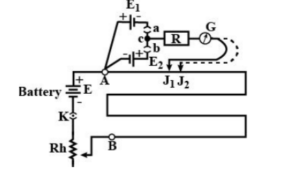When the current flows through the electrolyte present in an electrolytic cell, the solution offers internal resistance to the flow of the current across it. A potentiometer is a versatile instrument made up of a uniform wire connected across a standard cell. It is used to measure the emf of a cell and compare the emf of two cells. What comes as a bonus is using a potentiometer to measure the internal resistance of a cell. A potentiometer doesn’t draw current from the voltage source (cell); thus, it is not affected by the internal resistance of a cell.
Potentiometer – Comparison of emf
A potentiometer is manufactured from a material with high resistivity and low-temperature coefficient. After stretching the wires on a wooden board, they are joined in series with the help of thick copper strips.
When constant current flows through the wires of the potentiometer of the unit cross-sectional area, the potential difference between the two points is directly proportional to the length of the wire.

One application of the potentiometer is to compare the emf of two cells ε 1 and ε2.
1, 2, and 3 form a two-way key. When 1 and 3 are connected, the galvanometer is connected to ε 1, and when 2 and 3 are connected, it is connected to ε 2.
On moving the jockey around distance l1 from A to N1, you will not observe any deflection in the reading of the galvanometer. Under such conditions, according to Kirchoff’s law:
φ l 1 + 0 – ε1 = 0———(1)
On balancing ε2 against length l2
φ l 2 + 0 – ε2 = 0———(2)
On dividing equation 1 and 2:
ε1/ε2 = l 1/l 2
Choose one of the cells as a standard cell with a known emf. Thus, it becomes easy to find the emf of another cell.
Emf of a cell
An electric cell has potential due to the positive and negative electrodes immersed in an electrolytic solution. In the absence of the current, the potential of electrolytes is the same throughout. This potential difference between the positive electrode (anode) and the negative electrode (cathode) in an open circuit is called the electromotive force (emf) of a cell, denoted by ε.
The electromotive force is the measure of energy per unit charge. Thus, it measures the amount of energy resulting in the flow of the current in a circuit.
(V+) = Potential difference of positive terminal
(V-) = Potential difference of negative terminal
(V+) + ( V-) = Potential difference between P and N
V = Potential difference between P and A
+ Potential difference between A and B
+ Potential difference between B and N
= ε
V = (V+) +( V-) – Ir
V = ε – Ir
According to Ohm’s law, V = IR
IR = ε – Ir
ε = IR + Ir
ε = I(R + r)
What is back emf?
Due to the change in magnetic flux across a single isolated coil, an emf is induced in it. This self-induced emf is also called back emf. Back emf resists increase or decrease of current in the coil. Thus, the back emf works as inertia. To allow the flow of current through the circuit, work is done against back emf. Back emf or induced emf of a coil depends upon the geometry and permeability of the medium.
L = back emf or self-inductance
N = number of turns in the coil
ΦΒ = Magnetic flux
I = Current
The back emf in case of synchronous motor
A motor converts electrical energy into mechanical energy, while a generator converts mechanical energy into electrical energy. When the coil rotates, the motor behaves like a generator. When current passes through the coil, the motor’s shaft rotates, changing the magnetic flux and thus inducing electromotive force (emf). This induced emf resists any change in the inertia. Therefore, the emf powering the motor opposes the self-generated emf of the back emf of the motor.
The back emf of the motor is directly proportional to the angular velocity (ω). As the motor is turned on, angular velocity is zero; therefore, the motor draws maximum current and the coil receives full voltage from the energy source. As the motor turns faster, the back emf develops and increases. Since the back emf opposes the supplied emf, voltage and current decrease in the coil. When the motor rotates continuously at a slower speed, a large current flows through it, thus overheating it. Other examples of back emf are working with vacuum cleaners, refrigerators or washing machines.
Conclusion
Emf of a cell is the total potential difference between the two electrodes. The potentiometer doesn’t draw current from the source of voltage. It is used to measure the internal resistance of a cell and to compare two emfs. Back emf or induced emf resists the change in current in an electric circuit. This back emf is responsible for voltage drop when the motor rotates. The back emf is zero when the motor isn’t on and increases with the angular velocity of the motor.
 Profile
Profile Settings
Settings Refer your friends
Refer your friends Sign out
Sign out






